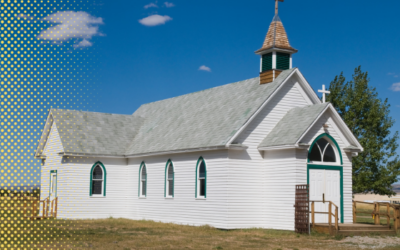“Christmas time is here
Happiness and cheer
A time that all the children call
Their favorite time of year.”1
Every year, as an eager child, I heard these lyrics sung as I participated in my annual viewing of A Charlie Brown Christmas (an annual viewing that goes on into my adult years as I watch this show with my own children). For many years this cartoon marked the beginning of the Christmas season for me. My thought was, “If A Charlie Brown Christmas is on TV then it must be Christmas time!” And why wouldn’t it be since the song starts off with the words: “Christmas time is here?!?”
Although my young mind was being influenced (and not in a bad way) by this Peanuts holiday favorite, at the same time it was also being formed by the time of year marked by the church as advent. Each year I noticed the advent transformation that occurred post-Thanksgiving, both in my own home and in my home congregation. In both places the advent wreath came out and was placed in a prominent position. My Lutheran elementary school teacher would bring out her advent calendar and each day she would pull this slip of paper from the banner-like calendar and read a devotion pertaining to that particular period in the advent season. This season also marked the extra-church services that we attended on Thursday nights that began with a soup supper. It was also during this time that I heard again the familiar old hymns, such as: “O Come, O Come Emmanuel.” These physical elements reminded me that it was not “Christmas time” that was “here;” rather it was advent time that had dawned upon us!
The word advent comes from the Latin word adventus, which means coming!2 Advent is a time of waiting. It is similar to the waiting, or the “I can’t wait” type waiting that children engage in during this time, as they anticipate the coming of Christmas morning and the brightly wrapped presents that will be waiting for them beneath the tree. As Christians there is indeed an anticipation in this waiting, an anticipation that culminates in another type of wrapped gift. But this wrapped gift is not wrapped in brightly colored paper, nor in ribbons and bows; rather it is wrapped in pieces of cloth. This gift is also not found underneath a tree; rather it is found in the most unlikely of placesa feeding trough for animals!3
Each advent Christians gather to reenact the waiting that the people of Israel, in the Old Testament, engaged in as they looked forward to the coming of the Messiah. One such prophet of “waiting” who figures prominently in our advent celebrations is Isaiah. Isaiah 40:3 records one ‘of the more known of the advent prophecies: “A voice of one calling: In the desert prepare the way for the LORD; make straight in the wilderness a highway for our God.'” Isaiah is also famously known for another advent proclamation found in chapter 9:6, “For to us a child is born, to us a son is given, and the government will be on his shoulders. And he will be called Wonderful Counselor, Mighty God, Everlasting Father, Prince of Peace.”
Advent is a time for the community of faith to once again relive the story of Jesus, which starts in bated breath anticipation for the Anointed One to be born in Bethlehem.4 It is also a time when we not only look back to the first coming of Jesus, but look forward to the Second Advent. Imagery born out of the first advent carries over in biblical passages concerning Christ’s second coming. Paul writes in Romans 8:20-22, “For the creation was subjected to frustration, not by its own choice, but by the will of the one who subjected it, in hope that the creation itself will be liberated from its bondage to decay and brought into the glorious freedom of the children of God. We know that the whole creation has been groaning as in the pains of childbirth right up to the present time.”
[bctt tweet=”We look back to the first coming of Jesus, and look forward to the second coming. #Advent”]
In Matthew’s famous discourse concerning the end of the age, Jesus says some comments that also echo similar sentiments made by Paul. Jesus states: “You will hear of wars and rumors of wars, but see to it that you are not alarmed. Such things must happen, but the end is still to come. Nation will rise against nation, and kingdom against kingdom. There will be famines and earthquakes in various places. All these are the beginning of birth pains.”5
The birthing language of Paul and Matthew that precedes the Second Advent of Jesus is very much reminiscent of the way in which Jesus came into the world in his First Advent. Jesus was birthed into the world through Mary, and now world events act as the birthing pains for Christ’s second in-breaking into the world.6 The Second Advent also is God’s final act upon the stage of human history. What had begun on that silent night in Bethlehem two-thousand years ago is completed in the near future return of Jesus.7
Why is it important for the church to celebrate this time of the year or any other for that matter? One reason is that the church year provides a reordering of the way in which we look at the nature of time. Robert Webber in his book, Ancient-Future Faith remarks that: “The Christian, in his or her view of time, makes a dramatic break with a secular view of time and begins to consciously meditate on the aspect of Christs life currently being celebrated by the church.”8
The adolescent experience is one that is fraught with much fragmentation. Time is something that many of them think they don’t have enough of given their busy lives between school, sports, work, band, choir, and, if time permits, church. But there is a deeper issue at hand in regards to the issue of fragmentation. Chap Clark in his foundational work on the dual life of teenagers notes that: “Alongside or, more accurately, beneath the superficial and all-too-often cosmetic layer of high school life, there are dark, lonely corners where the neon light of sanitized conformity seldom penetrates. Just below the sheen of coerced normality are the stress and strain of personal survival in a hostile world.”9 The message of advent that Christ has engaged in an in-breaking into the world is an important message to convey to teenagers who desperately need an in-breaking of Christ into their daily lives. And the Christmas season with its busy-ness is a perfect time to speak a “peace on earth” message.10
Experience Suggestions:
1) Filmic Meditation: The advent season brings with it a sense of contemplation. It calls to us to slow down and meditate upon both the past and future comings of Christ into the world. One way to do this is to develop a weekly meditation time, during the four weeks of advent, using the film The Nativity. Maybe this can be done in conjunction with your weekly advent services or done at another regular weekly meeting time. For starters pick four significant events in the story to use in your time together (such as the birth announcement to Mary, Joseph’s dream experience, the journey to Bethlehem, and the final scene of Jesus being born into the world).
Help set the mood by dimming the lights and lighting some candles, maybe those which carry some type of Middle-Eastern scent to them. Also have an advent wreath and nativity scene set up in a central location. If possible make the area a comfortable one with various pillows spread about. The idea is to establish a place where your teens can slow down, midst the craziness of life, and to use this time to focus upon Jesus.
Regarding the format of the event start each time lighting the advent wreath and maybe singing a verse from one of the more well known advent songs (such as “O Come, O Come Emmanuel”). If you have some musicians in the group ask them to help set the acoustical mood of the time together. Each week you can sing a different verse of the song or add a new one while singing the previous one. After the lighting of the advent wreath have one of your teens read a passage of Scripture that corresponds to the clip that you will be watching. You should use an advent passage that reflects the narrative. For instance when you watch the last part of the film where Christ comes into the world you should consider using Isaiah 9:6, which helps to show the connection between the Old and New Testaments. Resist using a verse that is shown in the movie (i.e. don’t have them read the birthing narrative, which they will then watch upon the film); rather help them to see the broader biblical perspective of this much anticipated event.
As you transition from the Bible reading time to the movie watching time have the youth spend a view minutes silencing their minds. Ask them to clear away all the other busy thoughts in their head so that they can focus on the meditation time ahead.
When you show your film clip make it a brief one. Also show the clip two or three times. After each time have them ponder the clip in a different way. Consider the outline below:
Viewing One: Just have them remain in silence thinking upon what they saw.
Viewing Two: Ask them: “Give a one word answer on your thoughts concerning this clip.”
Viewing Three: Ask them: “How does the OT and NT connect in this clip?”
Allow enough silent time for the youth after each viewing. Don’t rush them to answer, and don’t force them to answer. If the answer they give is internal then let it be that.
After the meditation time ask them to think about how this ancient narrative connects to the narrative of their lives. Give them space and time to really think this through. You may even give them some type of activity associated with this experience, such as drawing a picture, writing a poem, etc. After they are done with the activity, allow them to share the connecting points. Don’t try to force connections for them, and definitely allow them time to wrestle through all of this.
Close your time together in prayer and maybe a re-singing of the song that you opened your time with. The cyclical nature of the experience helps to reinforce the cyclical nature of the church year as we continually re-enact, as a community, the narrative of Jesus.
2) “Where’s the Christ Child?” – A few years ago there was a popular children’s book called, Where’s Waldo? The book was a picture hunt full of busy images in which the Waldo character was hidden within. Take this concept and notch it up a few degrees and have your youth engage in a city wide search for the Christ child. Hide clues around the city (with different folk in different locations) that correspond to events in the nativity narrative. The youth are to be like the “Wise Men” in their search for King Jesus. Creatively think through the places in your hometown or city and think about how they might act as contemporary replacements for the time of Jesus. When the students arrive at the final destination, engage them in a discussion on their experience and how it corresponds to the search by the Wise Men for Jesus.
3) “Highway for our God” – This can be an alternative to the event listed above. Take the above Isaiah 40 passage and use it in a creative way with your teens. Collect enough GPS units for each group and just give them each a starting address. As they reach their destination they must search for the next clue. Hide the clue, within plain site, with a person you know but maybe someone they have never met before. Tell them they are to go around asking people, “Do you know where the Christ child is?” The person who has the clue should respond, “Yes, I do know where the Christ child is,” and then precede to give a clue with a new address upon it. Include on each paper an extra clue. The extra clue would be parts of the Bible reference, Galatians 2:20. At their final destination point they would be able to put all the clues together and look up the passage, which talks about how we, as Christians, have Christ living within. Engage in a discussion concerning how through baptism we all have the Christ-child within us! Tell them that God comes to us in our baptismal stories, just like God came to the world in the Christmas narrative. Consider ending you time together with a “birthday party” celebrating the birth of Jesus, and all of our baptismal births in Christ.
4) La Posadas – In Latin American culture they do an annual activity where adults and children venture around a city, knocking on doors, and asking if there is room within. The singing of songs is accompanied with this event. The experience reflects the story of Joseph and Mary seeking to find a place to stay within Bethlehem. Adapt this experience and use it as a time to sing Christmas carols around the neighborhood. Set-up ahead of time, with your church members, that the students will be coming to their house seeking a place to stay. But add a creative twist and tell them that in the process of doing their door to door search they will be collecting food or clothing items which they will be donating to a local shelter (you can establish a creative dialogue where the youth ask to seek shelter within, but have your parishioners tell them there is no room within, but that they do have something to share within them for their journey). Set it up that at the last house they come to they are invited in and provided a simple meal. Use this time to connect the search, the gathering of items, and the simplicity of the meal to talk about the poor nature of Jesus and how this King of kings was not born to wealth, but to poverty. Continue the experience by taking the youth to the local shelter or food pantry where they engage in a time of service with the poor and homeless.
1 Vince Guaraldi, Christmas Time is Here [vocal version]. in A Charlie Brown Christmas, 1965, Compact Disc.
2 http://en.wikipedia.org/wiki/Advent viewed on September 16, 2009.
3 See Luke 2:7
4 Robert E. Webber, Ancient-Future Time: Forming Spirituality through the Christian Year, 2nd print (Grand Rapids: Baker Books, 2006), 21.
5 Matthew 24:6-8
6 Webber, 44.
7 Stating that Christ’s second coming is near is not trying to claim some sort of knowledge about when it will occur (see Matt. 24:36). Rather Christians ever since the ascension of Christ have lived in this constant anticipated sense of Jesus’ near return.
8 Robert E. Webber, Ancient-Future Faith: Rethinking Evangelicalism for a Postmodern World, (Grand Rapids: Baker Books, 1999), 112.
9 Chap Clark, Hurt: Inside the World of Today’s Teenager, (Grand Rapids: Baker Academic, 2004), 19.









0 Comments